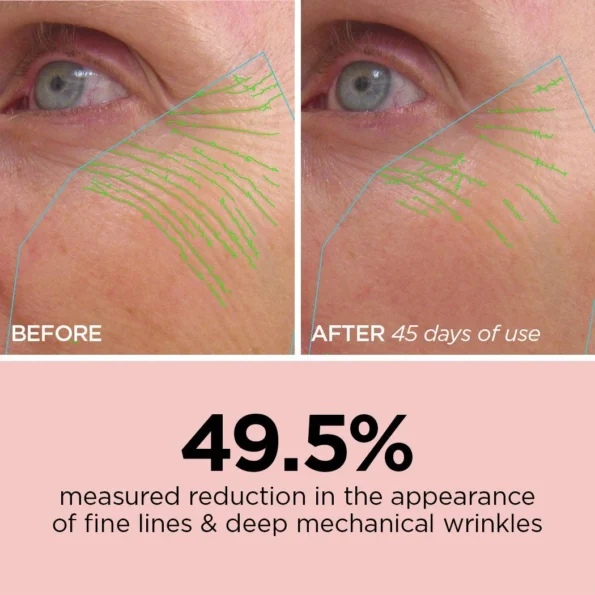Introduction
Retinol has become a buzzword in the skincare industry, known for its incredible anti-aging benefits. Whether you’re looking to reduce fine lines, improve skin texture, or achieve a youthful glow, retinol is an essential ingredient to consider. This beginner’s guide will cover everything you need to know about retinol, including its benefits, how to start using it, when to apply, what not to mix, and recommended dosages for beginners and advanced users.

What is Retinol?
Retinol is a form of Vitamin A that promotes cell turnover and stimulates collagen production. It is widely used in skincare products for its ability to combat signs of aging, acne, and hyperpigmentation. Retinol works by accelerating skin renewal, helping to fade dark spots and improve overall skin tone.
Related Link: WebMD on Retinol Benefits
Benefits of Retinol for Anti-Aging
Incorporating retinol into your skincare routine offers numerous anti-aging benefits, such as:
- Reduces Fine Lines and Wrinkles: Retinol helps stimulate collagen production, which smoothens wrinkles and fine lines.
- Improves Skin Texture: It promotes cell turnover, leading to smoother and brighter skin.
- Fades Hyperpigmentation: Retinol lightens dark spots and evens out skin tone.
- Boosts Collagen Production: With consistent use, retinol supports skin elasticity and firmness.
- Prevents Acne: It helps unclog pores and reduce breakouts.
Related Link: Healthline – Retinol Benefits
How to Start Using Retinol
Starting retinol can be daunting, especially for beginners. Here is a step-by-step guide to help you ease into using retinol safely:
- Choose the Right Product: Start with an over-the-counter retinol serum or cream with a low concentration (0.25% to 0.5%).
- Start Slowly: Use retinol only once or twice a week to allow your skin to build tolerance.
- Apply on Clean, Dry Skin: Always apply retinol at night on dry skin to minimize irritation.
- Follow with Moisturizer: To combat potential dryness and irritation, apply a gentle, hydrating moisturizer after retinol.
- Use Sunscreen Daily: Retinol can make your skin more sensitive to the sun, so always use SPF 30 or higher during the day.

When to Use Retinol
The best time to apply retinol is at night, as it can break down when exposed to sunlight. A suggested nighttime routine includes:
- Cleanse your face with a gentle, non-exfoliating cleanser.
- Pat your skin dry completely.
- Apply a pea-sized amount of retinol to your face, avoiding the eye area.
- Finish with a moisturizer.
What Not to Mix with Retinol
Using retinol with the wrong ingredients can lead to irritation and counteract its benefits. Avoid combining retinol with:
- Benzoyl Peroxide: Can deactivate retinol’s effectiveness.
- Alpha Hydroxy Acids (AHAs) and Beta Hydroxy Acids (BHAs): Can increase sensitivity and cause irritation.
- Vitamin C: May lead to excessive dryness and irritation.
- Exfoliants: Using physical or chemical exfoliants along with retinol can lead to over-exfoliation.
- Fragranced Products: May irritate the skin and cause redness.
Pro Tip: Stick to a gentle skincare routine with hydrating and soothing ingredients like hyaluronic acid and ceramides.
Beginner vs. Advanced Retinol Dosage
Beginner Dosage:
- Start with a low concentration (0.25% – 0.5%) once or twice a week.
- Gradually increase to every other night as your skin builds tolerance.
- Always monitor for irritation such as redness, dryness, or peeling.
Advanced Dosage:
- Use higher concentrations (1% and above) if your skin is well-adapted.
- Apply retinol every night for maximum results.
- Consider prescription-strength retinoids under dermatological supervision.
Related Link: Mayo Clinic – Retinol Usage
Common Side Effects of Retinol
While retinol offers numerous benefits, it can cause side effects, especially when starting. Some common side effects include:
- Dryness and peeling
- Redness and irritation
- Increased sensitivity to sunlight
To minimize side effects:
- Start with a low dose.
- Use moisturizer and sunscreen daily.
- Avoid using harsh skincare products.
FAQs About Retinol
Q1: Can I use retinol every day?
A: Beginners should start 1-2 times per week and gradually increase usage.
Q2: Can I use retinol if I have sensitive skin?
A: Yes, but opt for a lower concentration and hydrate well.
Q3: How long does it take to see results?
A: Visible improvements can take 8-12 weeks with consistent use.
Conclusion
Retinol is a powerful anti-aging ingredient that, when used correctly, can significantly improve your skin’s appearance and texture. Whether you’re a beginner or an advanced user, following a gradual approach and avoiding harmful combinations will ensure optimal results.
If you’re new to retinol, remember to start slow, use it at night, and always apply sunscreen during the day. By incorporating retinol into your skincare routine, you can achieve youthful, radiant skin for years to come.
Start your retinol journey today and enjoy its remarkable anti-aging benefits!



